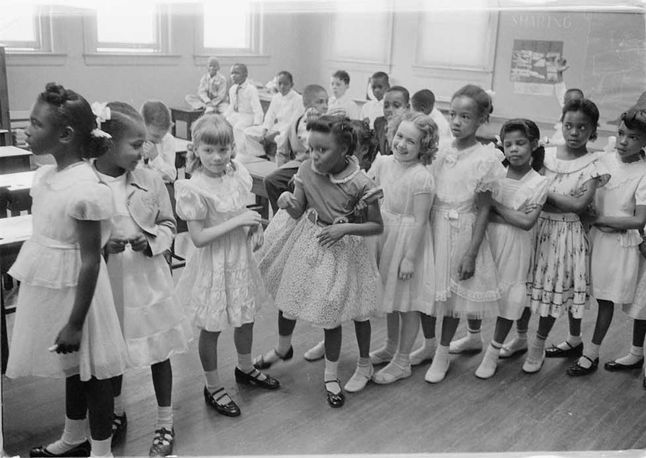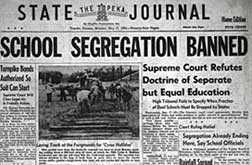Board of Education of Topeka case in which on May 17 1954 the US. Synopsis may belong to another.
 Brown V Board National Geographic Society
Brown V Board National Geographic Society
US History Mulvey Brown v.
Brown v the board of education of topeka. Supreme Court declared state laws establishing separate public schools for students of different races to be unconstitutional. They brought this action in the United States District Court for the Diftrict of Kansas to enjoin enforcement of a Kansas statute which. The Brown Foundation succeeds because of your support.
Board of Education of Topeka Shawnee County Kansas et al. But Topeka Kansas was not the only city at the forefront of this landmark case. Board of Education of Topeka was a landmark 1954 Supreme Court case in which the justices ruled unanimously that racial segregation of children in public schools was unconstitutional.
On May 17 1954 Supreme Court Justice Earl Warren delivered a ruling in the Brown v. In 1950 Shirley Bulah was forced to. On May 17 1954 in a landmark decision in the case of Brown v.
Brown v Board of Education of Topeka was one of the most important legal decisions in the US of this century and the effects of desegregation and the legacy of the civil rights movement still influences race relations today. We use the support from individuals businesses and foundations to help ensure a sustained investment in children and youth and to foster programs that educate the public about Brown v. Long before Brown v.
In 1849 in the case of Roberts v. Board of Ed Brown v. In this case the Court held that racial segregation in the District of Columbia public schools violated the due process clause of the Fifth Amendment.
Brown at the head of the roster would be better received by the US. Board of Education the plaintiffs are Negro children of elementary school age residing in Topeka. Board of Education in the context of the civil rights movement and to advance civic engagement.
In the case that would become most famous a plaintiff named Oliver Brown filed a class-action suit against the Board of Education of Topeka Kansas in. The case Oliver Brown et al. Board of Education of Topeka ruled that public education can not be segregated on the basis of race 1954.
The Board of Education of Topeka Kansas was named after Oliver Brown as a legal strategy to have a man at the head of the roster. They brought this action in the United States District Court for the District of Kansas to enjoin enforcement of a Kansas statute which permits but does not require cities of more than 15000 population to maintain separate school facilities for Negro and white students. In the Kansas case Brown v.
This case took on segregation within school systems or the separation of White and Black students within public schools. Supreme Court ruled unanimously 90 that racial segregation in public schools violated the Fourteenth Amendment to the Constitution which prohibits the states from denying equal protection of the laws to any person. The decision dismantled the legal framework for racial segregation in public schools and Jim Crow laws which limited the rights of African Americans particularly in the.
Board of Education of Topeka 347 US. The Board of Education of Topeka became part of the national legal landscape African American parents were initiating court cases to challenge segregated public schools. Supreme Court filed a separate opinion on Bolling because the Fourteenth Amendment was not applicable in Washington DC.
One of the most historical court cases especially in terms of education was Brown v. Board of Education of Topeka was a landmark 1954 supreme court case in which the justice ruled unanimously that racial segregation of children in public schools was unconstitutional. Board of Education of Topeka Kansas the US.
In this book over 30 primary documents place the Brown case in its historical context with both contemporary and historical documents. In the Kansas case Brown v. Board of Education caseIt was determined that state sanctioned segregation was a violation of the 14th Amendment and therefore unconstitutional.
Up until this case many states had laws establishing separate schools for White students and another for Black students. The lawyers and the National Chapter of the NAACP also felt that having Mr. Board of Education was one of the cornerstones of the Civil Rights Movement and helped establish the precedent that separate-but-equal education.
Board of Education of Topeka. This nullified the ruling of the Plessy vFerguson case in 1896 which allowed states to maintain segregated schools. The first documented school case took place before the Civil War.
Board of Education Brown v. 2 Oliver Brown et al. Board of Education the plaintiffs are Negro children of elementary school age residing in Topeka.
Board of Education was one of cornerstone of civil rights movements and helped establish the precedent that. Oliver Brown was one of the plaintiffs in.
The Court found the practice of segregation in public schools unconstitutional and refused to apply its decision in. The Supreme Court took the relatively unusual step in Brown v.
 Brown V Board Of Education Of Topeka Part 2 National Archives
Brown V Board Of Education Of Topeka Part 2 National Archives
Supreme Court ruled unanimously 90 that racial segregation in public schools violated the Fourteenth Amendment to the Constitution which prohibits the states from denying equal protection of the laws to any person within their jurisdictions.
Brown v board of education of topeka summary. Federal court against the Topeka Board of. Board of Education was a landmark case in the United States Supreme Court in which the doctrine of separate but equal specifically in regard to public education was deemed unconstitutional. Board of Education of Topeka was a landmark 1954 Supreme Court case in which the justices ruled unanimously that racial segregation of children in public schools was unconstitutional.
In 1954 Oliver Brown and twelve other local black families in Topeka Kansas filed a class-action lawsuit in the US. Linda Browns Family and many other families sued for their children because public schools were not letting them enroll in these schools because they only allowed whites. In a unanimous decision the Supreme Court ruled in favor of the Browns.
After the District Court upheld segregation using Plessy v. Board of Education of Topeka 347 US. In 1954 the United States Supreme Court decided that public schools should not be segregated.
Brown V Board of Education 1. Black children were denied admission to schools attended by white children under laws that permitted or required segregation by race. In December 9th 1952 the Board of Education of the city of Topeka Kansas had a suit filed against them because of their racial segregation between Caucasian and African American students.
This week in black history the Brown Vs Board of Education Decision was GivenSome of our best videos are still coming please subscribe to the channelSubscr. This case was based around segregation in schools. Board of Education of Topeka case in which on May 17 1954 the US.
The Supreme Court ruled for Linda Brown and the other students. Get more case briefs explained with Quimbee. The case was composed of five cases that were all grouped into one and named Brown v.
As a representative of a class action suit Brown filed a claim alleging that laws permitting segregation in public schools were a violation of the 14 th Amendment equal protection clause. Chief Justice Earl Warren delivered the opinion of the Court ruling that segregation in public schools violates the 14. The decision was unanimous.
Segregation means keeping Blacks and whites separate. Board of Education of Topeka 1954 2018 Street Law Inc. To the field of public education Chief Justice Earl Warren wrote the opinion for the.
Federal court against the Topeka Board of filed a class-action lawsuit in the US. The second round of oral arguments was almost entirely about the circumstances of the Fourteenth Amendments passage and its intended effect on public education. Board of Education of Topeka case is a well-known case that went to the Incomparable Court for racial reasons with the leading body of training.
This case took on segregation within school systems or the separation of White and Black students within public schools. Board of hearing oral arguments twice once in 1953 and again in 1954. Topeka Board of Education Appeal - October 1952 Summary In October 1953 the Topeka Board of Education submitted a brief to the United States Supreme Court in response to.
Summary of Brown v. The Court decided unanimously 9-0 for the plaintiffs overturning the Plessy v Ferguson 1896 decision in the context of education. Case Summary of Brown v.
These cases were Brown v. Board of Education of Topeka. Most simply refer to it as Brown v.
Board of Education The Brown v. Board of Education Summary This landmark case began in Topeka Kansas during the 1950s. The case was really the name given to five separate cases that were heard by the US.
Preeminent Court concerning the issue of isolation in state funded schools. One of the most historical court cases especially in terms of education was Brown v. Up until this case many states had laws establishing separate schools for White students and another for Black students.
Oliver Brown was denied admission into a white school. Amendments Equal Protection Clause. That is why the case is called Brown v.
Board of Education of Topeka was a court case about segregation in United States public schools. Board of Education of Topeka even though the case involved plaintiffs in multiple states. Summary of Facts no more than 4 sentences a.
Board of Education of Topeka I Summary of Decision. Board of Education of Topeka Brown I Citation 347 US483 74 S.